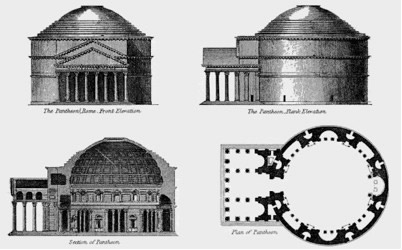The Pantheon consists of a 34m by 13.6m ‘pronaos’, or portico, and a 43.2m inner diameter circular ‘cella’, or main temple, crowned by a dome.
The pronaos has three rows of Corinthian columns that stand 14 meters tall. Each weighs 60 tons. Presumably there were originally eight columns in each row, the first of grey granite and the remaining rows of red granite.
The cella is heavy on the bottom and gets lighter at the top. In this way, it is structurally sound without any reinforcing support, even though the internal volume of the Pantheon is 1,520 square meters.

No one knows for certain the number of deities worshipped in the Pantheon, but there is one theory that takes into account the inner arrangement of the cella. The theory is that the seven niches between each pair of Corinthian columns housed the seven planetary deities: Mercury, Venus, Mars, Jupiter, Saturn, Uranus, and Neptune.
